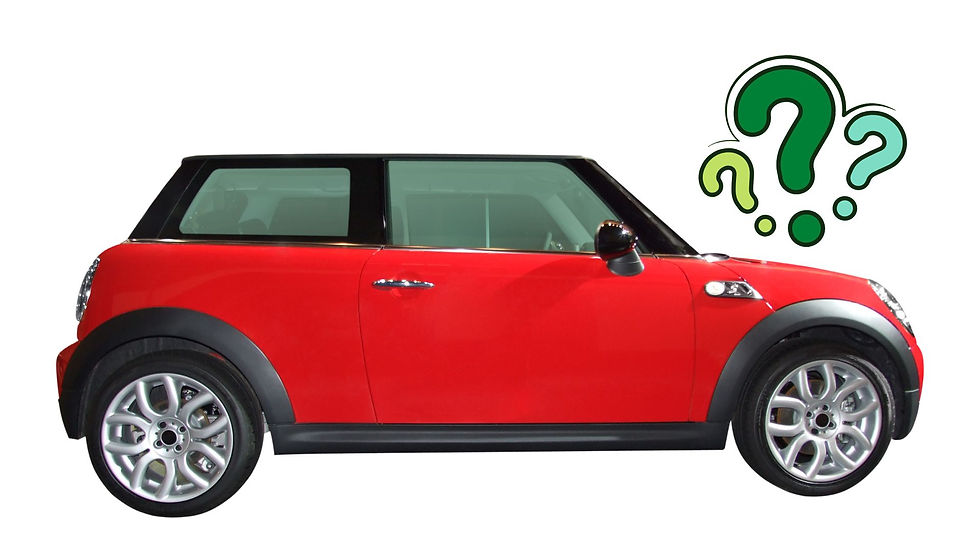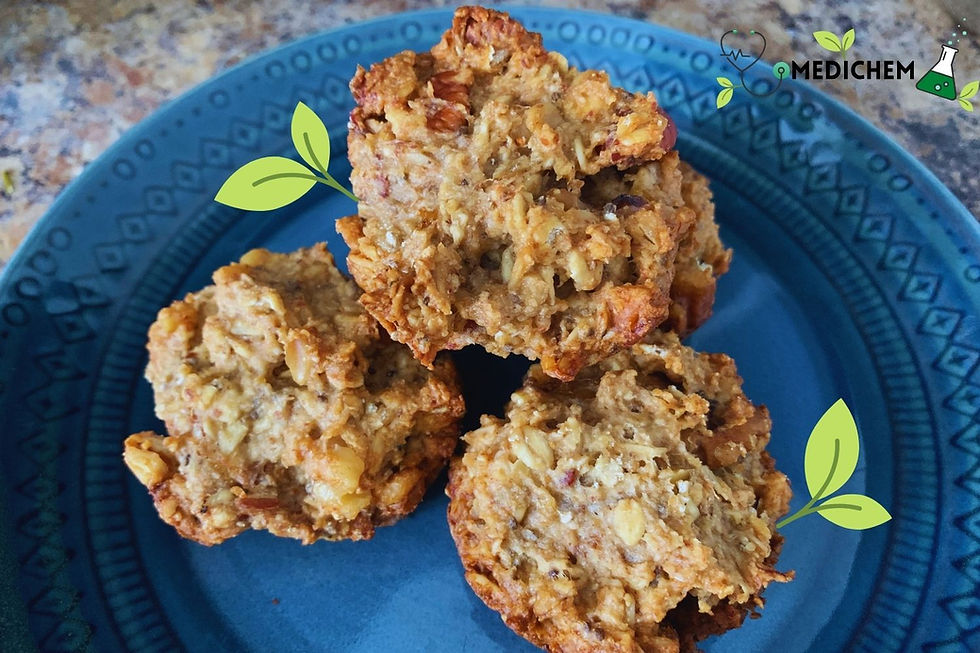Cookies, Calories, and Context: Why Food Isn’t Good or Bad
- Dr. Chelsea Anorma

- Jul 24
- 6 min read
Let’s Start with a Car
(What Mini Coopers Can Teach Us About Food Judgment)
Picture this: a bright red Mini Cooper with two doors and black trim around the wheels and windows.
Now, quick, I need you to make a decision. It’s important:
Is this a good car? Should I buy it?

You might be saying to yourself right now, “I don’t know, Chelsea! It depends!”
Which would be right, of course. How could you possibly know if this car is good or not just by looking at it, without any information about what it’s for?
What if I need to haul a family of six? Not ideal. But if I want a fun weekend car to drive around the island with my husband, it might be perfect.
The same car could be “bad” in one case and “perfect” in another.
We instinctively know that we can't just label a car as good or bad; instead, we decide whether it is good for the intended purpose.
A pickup truck is great for hauling construction supplies, but not great for carrying more than five people (safely). A van is ideal for transporting kids and their gear, but not for off-roading or driving through a flooded road. (Unfortunately, I know that last one from experience!)
However, I noticed something strange. We don't apply this same thinking to food.
The Trap of “Good” vs. “Bad” Foods
Why Context Matters More Than Labels
When it comes to food, we’re often taught that everything needs a moral label. Good or bad. Clean or dirty. Healthy or unhealthy.
There are endless lists, and even entire apps, designed to rank or color-code our food choices. Because of all this confusion, one of the most common questions I get from my clients is:
“Can I eat this food? Is it good or bad?”
Just like with cars, the real answer is: It depends.
What Makes Food “Healthy”?
Ask These 3 Questions First
Instead of thinking of food as “good” or “bad,” I like to picture it on a spectrum — a healthiness scale. Where a food lands on that scale depends on three questions:
What job is this food meant to do?
Does it meet my current needs?
Compared to what? What other food options are available?

That last question is key. A food can’t be labeled healthy or unhealthy without knowing what the other options are in the moment.
Sometimes, a food that’s been labeled “bad” might be your best option — especially compared to skipping a meal or grabbing something ultra-processed.
Let’s look at a real example!
This Cookie Surprised Me
It’s Plant-Based, High-Calorie, and Still Worth Baking
Cookies are probably one of the first foods that come to mind when people think about “bad” foods.
But as a plant-based nutrition geek, there’s one cookie recipe I keep coming back to again and again.
It’s adapted from The No Meat Athlete Cookbook by Matt Frazier and Stepfanie Romine. (It’s an excellent book, by the way — here’s my affiliate link if you’d like to check it out!)
The original name? Calorie Bomb Cookies.
Sounds even worse, right? Not just a cookie… but one bursting with calories?!
Calories Aren’t Bad: They’re Energy
And Sometimes You Need a Lot of Them
Here’s the context: the authors developed this recipe as fuel for ultra-long bike races. So it was purposefully created to deliver a lot of calories.
Calories have gotten a bad rap on social media, but they’re literally just a unit of energy. Your body needs a certain amount of energy to keep you going, even at rest. Add intense physical activity on top of that, and you burn a lot more!
In that context, a cookie packed with calories is exactly what their bodies needed.
It also matters what the cookies were being compared to. These cookies were replacing sugary drinks or ultra-processed energy bars. They got the job done while also providing nutrients from whole food ingredients.
One Recipe, Many Seasons
From Long Runs to Late-Night Feedings
I may not be a long-distance athlete, but when I first discovered this recipe, Dr. Gio and I were regularly running together. We were both experimenting with plant-based eating and looking for something quick to refuel after a run and before work.
These cookies were:
Free of the dairy and eggs that were triggering skin and digestive issues
Easy to prep ahead
More nutritious than a grab-and-go donut or sugary cereal
Years later, this same recipe became a staple during a completely different season of life.
After having two beautiful babies in two years, I was breastfeeding my newborn full-time while also wrangling my little toddler. In this context, it was a lifesaver to have a quick source of energy and nutrients that supported milk production — and I could eat them with one hand!
They were also a favorite snack for Dr. Gio during 24-hour shifts in the emergency department, something he could grab between patients and trust would keep him full a little longer.

My Favorite Plant-Based Cookie Tweaks
Because the “Best” Choice Isn’t Always the Same
Over the years, I’ve adapted this recipe to fit our needs better, always asking those three questions: What’s it for? Does it match my needs? Compared to what?
Here’s how I’ve modified it:
Swapped coconut oil for canola or vegetable oil Coconut oil is higher in saturated fat. Canola and vegetable oils offer more unsaturated fats, which may be a better fit for many people’s heart health goals.
Increased chia and flax This boosts the fiber content and adds omega-3s.
Used less brown sugar and swapped chocolate chips for pecans A small way to reduce added sugars while still offering something satisfying and rich.
Each of these changes was made with context in mind. Not to make the cookie “good,” but to make it work better for us!
Try It Yourself
Ready to make your own batch of Calorie Bomb Cookies?
They are now called Grab and Go Energy Cookies! → Grab my personalized version of the recipe here — it’s free!
It’s exclusive to our email community, so you’ll be asked to share your email before getting access. Once you’re in, you’ll get the full list of ingredients and instructions, It’s easy to adjust the recipe size to fit your needs using the slider, and you'll see all the nutrition facts in the nutrition tab.
And remember, you don’t have to follow it exactly. I’ve made plenty of swaps over the years to fit our needs, and you can do the same! That’s the beautiful thing about food: there are so many ways to make it work for your body, your schedule, and your preferences.
We’re blessed to live in a time and place where we have options. So if one recipe doesn’t quite fit, don’t give up — try something new, tweak what you’ve got, or explore a completely different idea!
If You’re Focusing on Weight Loss
Here’s How to Enjoy These Cookies Mindfully
It’s true. Each of these cookies packs around 200 calories, and they’re delicious, which means it can be easy to eat more than one!
If you're working toward weight loss or trying to stay in a calorie deficit, it helps to enjoy them strategically. That might mean planning for just one as a post-workout snack or pairing them with less calorie-dense foods throughout the day.
The good news? These cookies offer more than just calories. Their higher fiber content can help you stay full longer than many store-bought treats. And because you’re making them from scratch, you naturally become more intentional about eating them — unlike prepackaged snacks that are easy to overeat straight from the box.
This isn’t about guilt. It’s about awareness and choice. The more you understand your needs, the more freedom you have to enjoy what fits.
Want More Support in the Kitchen?
If you found this helpful, we’ve got more coming soon! We're working on a few new resources to help you feel more confident cooking meals that fit your real life, whether you're feeding a family, navigating food sensitivities, or just trying to eat more plants without overthinking it.
The best way to stay in the loop is to join our email list. That way, you'll be the first to hear about new recipes, upcoming programs, and kitchen inspiration we're creating with you in mind.
And if you’d like more personal support, we also offer 1:1 coaching. You can book a free discovery call anytime to learn how we help clients build meals that work for their unique needs, preferences, and goals.
You don’t have to figure it all out alone. We're here to help!
 | Dr. Chelsea Anorma, PhD, NASM-CNC, is a Certified Nutrition Coach and Chemical Biology PhD helping overwhelmed women regain energy and confidence through sustainable, science-backed wellness coaching. |



Comments